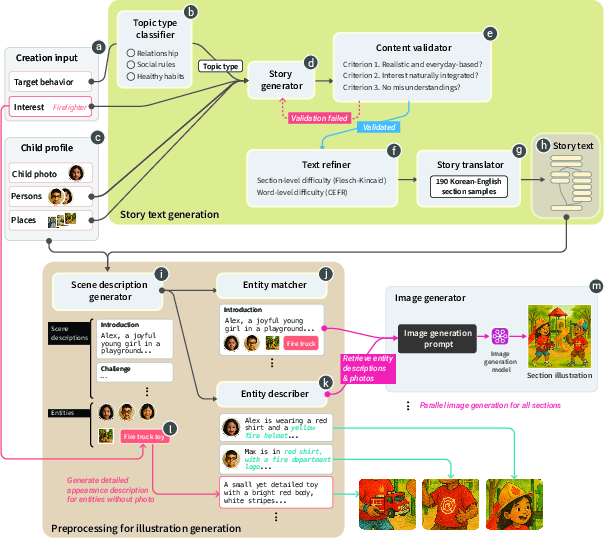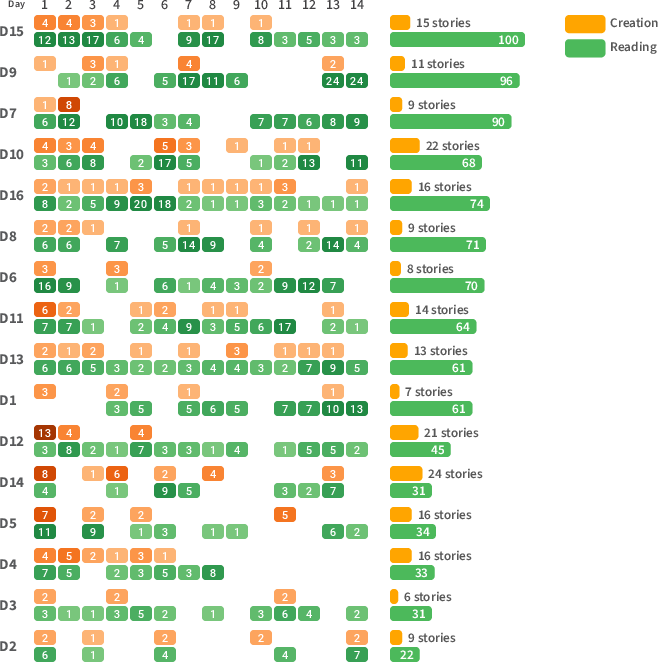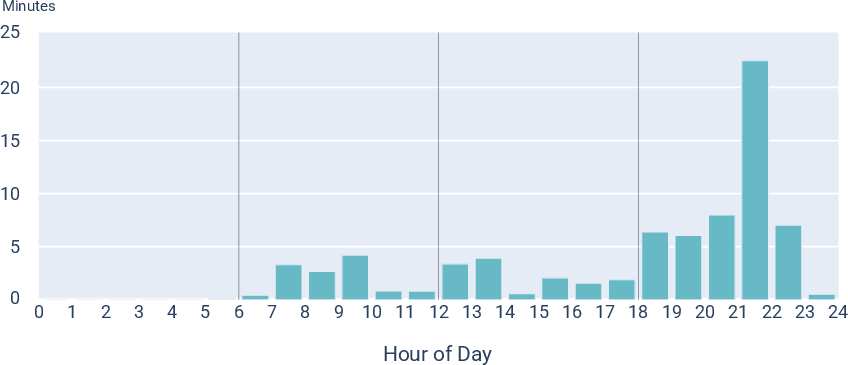- The paper introduces a dual-component system that integrates LLMs and image synthesis to generate personalized social narratives for autistic children.
- It details a multi-stage generative pipeline validated through a two-week field study with 16 parent-child dyads, emphasizing contextual relevance and visual engagement.
- Results demonstrate high parental engagement and positive behavioral shifts, underscoring AI’s potential in enhancing narrative-based autism interventions.
AutiHero: Generative AI for Personalized Social Narratives in Autism Behavioral Guidance
Introduction and Motivation
AutiHero introduces a generative AI-based system for the creation and delivery of personalized social narratives, targeting the unique behavioral guidance needs of autistic children. The system is motivated by the well-documented challenges autistic children face in interpreting implicit social cues and the substantial burden placed on parents to repeatedly explain social norms and expectations. Traditional social narrative interventions, while effective, are often static, labor-intensive to personalize, and lack the narrative richness required to sustain engagement. AutiHero leverages LLMs and text-to-image models to automate the generation of contextually grounded, visually rich, and highly personalized stories, thereby reducing parental burden and enhancing the efficacy of at-home behavioral interventions.
System Design and Architecture
AutiHero is architected as a two-component system: the Creator (web-based) for story authoring and the Reader (tablet-based) for shared reading. The design is informed by formative interviews with autism experts, emphasizing three core rationales: (1) making the child the protagonist to maximize engagement and self-modeling, (2) deep personalization to the child’s interests, familiar people, and everyday contexts, and (3) interactive, multi-path story structures to facilitate behavioral rehearsal and exploration.
The story structure is strictly controlled to ensure ethical, concrete, and developmentally appropriate content. Each story comprises a title, introduction, challenge, branching decisions (desirable and undesirable), consequences, repair opportunities, and a shared positive ending. This structure is designed to allow children to explore both correct and incorrect behavioral choices, with all paths converging on a constructive resolution, thus supporting error repair and resilience.

Figure 1: Example story structure with desirable and undesirable paths, illustrating the branching and repair mechanism central to AutiHero’s narrative design.
The system’s generative pipeline is modular and multi-stage. It includes a topic classifier, story generator, content validator, text refiner (with Flesch-Kincaid and CEFR-based difficulty control), and a translation module for Korean localization. Visual illustration generation is handled by a scene description generator, entity matcher/describer (incorporating user-uploaded photos), and an image generator prompted for classic children’s book aesthetics.

Figure 3: Pipelines for generating story text and visual illustrations, showing the integration of user input, LLM-based text generation, and image synthesis.
The backend is implemented in Python (FastAPI), with React.js for the Creator and React Native for the Reader. LLM inference and image generation are orchestrated via LangChain, with data persistence in PostgreSQL.
Deployment Study: Methodology and Results
A two-week field deployment was conducted with 16 autistic child-parent dyads. Inclusion criteria ensured participants had sufficient reading comprehension and access to required hardware. The paper protocol included an in-home introductory session, 14 days of free system use, daily experience surveys, and a post-paper debriefing with TAM-based quantitative and qualitative assessments.
Parents created 218 stories (mean 13.6 per parent), with high engagement in both creation and reading (mean 4.25 stories read per day). Story topics spanned social norms, self-care, social interaction, safety, emotion regulation, and new experiences, closely mirroring the domains of the ADI-R diagnostic framework. Personalization was extensive, with 98 unique interests across 10 categories reflected in the stories.

Figure 2: Distribution of story creation and reading sessions over the 14-day deployment, indicating sustained and regular engagement.

Figure 6: Illustrations excerpted from participants' stories, demonstrating the integration of personalized interests, places, and persons.
Reading sessions predominantly occurred in the evening, aligning with established bedtime reading routines. Children’s engagement was rated highly (mean 4.02/5), and parents reported that the personalized content increased attention and participation. The multi-path structure facilitated proactive child involvement and parental guidance, though some parents requested greater structural variety and more interactive features.

Figure 4: Distribution of story reading durations by hour, with a peak in the evening, reflecting naturalistic integration into family routines.
Impact on Behavioral Guidance and Parenting
Parents reported positive behavioral changes in 72% of targeted behaviors, with improvements observed in domains such as social interaction, overcoming fears, and daily living skills. Notably, behaviors related to stimming and impulsivity were less responsive, highlighting the limits of short-term narrative interventions for deeply ingrained traits.

Figure 9: Reported changes in children’s and parental behaviors, with the majority of parents observing positive shifts in both domains.
Parental responses to challenging behaviors also shifted, with 82% reporting more constructive, less punitive approaches. The process of story creation itself was cited as a reflective exercise, prompting parents to reconsider their strategies and focus on positive reinforcement rather than scolding.
Implementation Considerations and Trade-offs
Personalization vs. Scalability: The system’s reliance on parent-provided context (photos, interests, target behaviors) enables high personalization but introduces variability in story quality and relevance. Automated topic suggestion and scaffolding mechanisms are proposed to support parents with limited insight into appropriate behavioral targets.
Ethical and Developmental Safeguards: Strict story structure and content validation are essential to prevent the generation of inappropriate, culturally misaligned, or developmentally unsuitable narratives. The system’s design ensures all behavioral paths are repairable and converge on positive outcomes, mitigating the risk of negative reinforcement.
Resource Requirements: The generative pipeline, leveraging GPT-4o and gpt-image-1, achieves sub-3-minute end-to-end storybook generation with parallelized image synthesis. However, reliance on commercial APIs may introduce cost and latency constraints at scale.
User Experience: The dual-app architecture (web Creator, tablet Reader) supports both asynchronous authoring and synchronous shared reading. Parents valued the low-burden, mobile-friendly interface, though requests for richer narrative diversity and more granular control over illustrations were noted.
Theoretical and Practical Implications
AutiHero demonstrates that generative AI can operationalize the principles of evidence-based social narrative interventions at scale, while preserving the critical element of personalization. The system’s design aligns with best practices in autism intervention—explicit, concrete, contextually grounded instruction—while reducing the cognitive and logistical load on parents.
The empirical results suggest that parent-driven, AI-assisted story creation can serve as both an intervention and a reflective parenting tool, fostering more positive parent-child interactions and supporting the generalization of social skills. The system’s capacity to cover the full spectrum of autism-related behavioral challenges, as evidenced by the diversity of created stories, underscores its potential as a comprehensive at-home support tool.
Limitations and Future Directions
The paper’s reliance on parent-reported outcomes and the short deployment window limit the generalizability of behavioral impact findings. Gender imbalance among participants and the absence of direct child-centered measures are additional constraints. Future work should explore longitudinal deployments, direct observation, and integration of automated behavior tracking to more robustly assess efficacy.
Enhancements to the system could include adaptive difficulty control, serialized or alternative narrative structures, and expanded interactive modalities (e.g., puzzles, open-ended questions). Safeguards for topic selection and framing, informed by clinical guidelines, are critical to ensure ethical and effective use.
Conclusion
AutiHero provides a technically robust, empirically validated framework for leveraging generative AI in the creation of personalized social narratives for autistic children. By automating the generation of contextually rich, visually engaging, and developmentally appropriate stories, the system empowers parents to deliver nuanced behavioral guidance with reduced burden. The findings highlight the promise of AI-driven co-creation tools in augmenting both child learning and parental reflection, with implications for the broader design of accessible, personalized intervention technologies in neurodevelopmental contexts.





